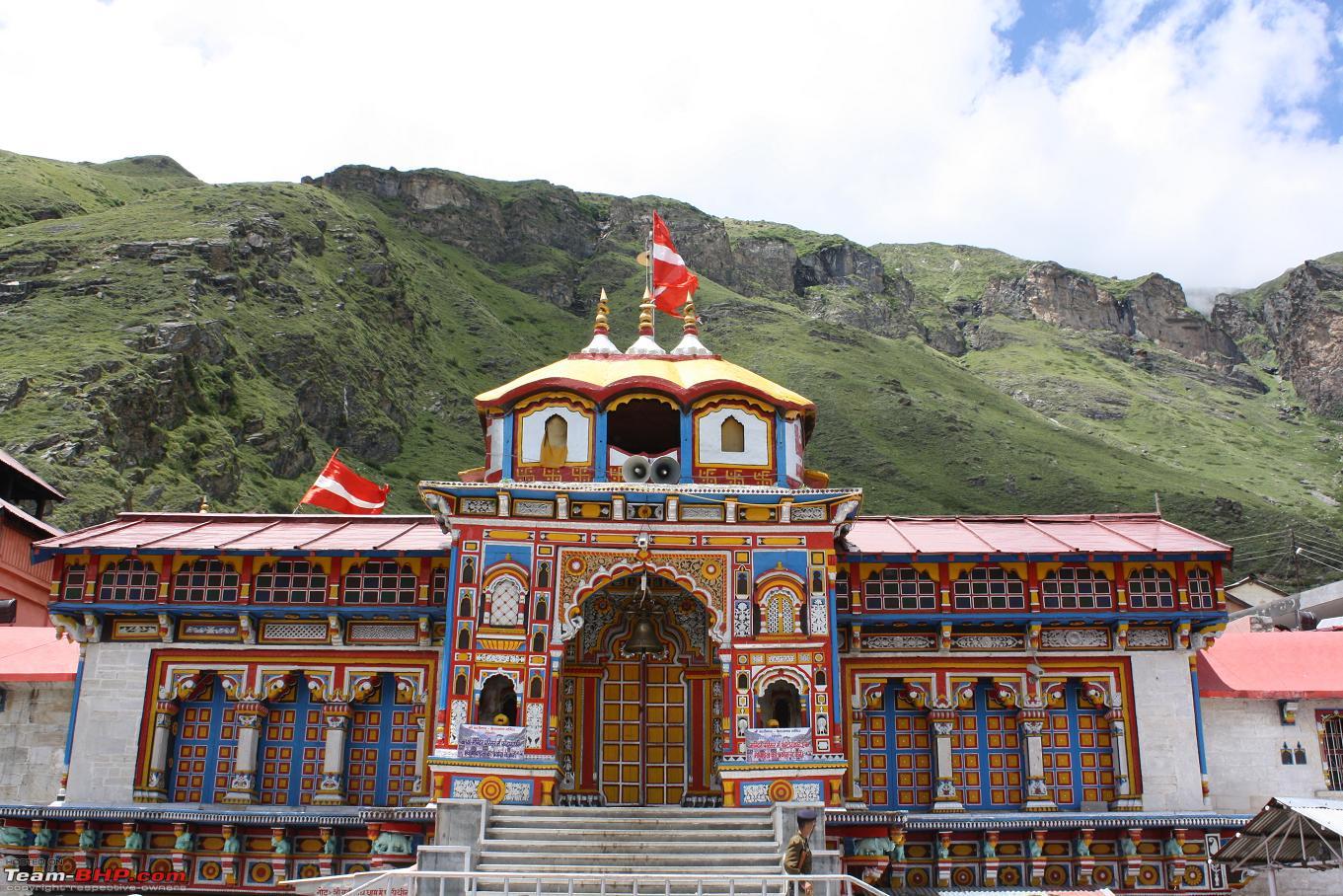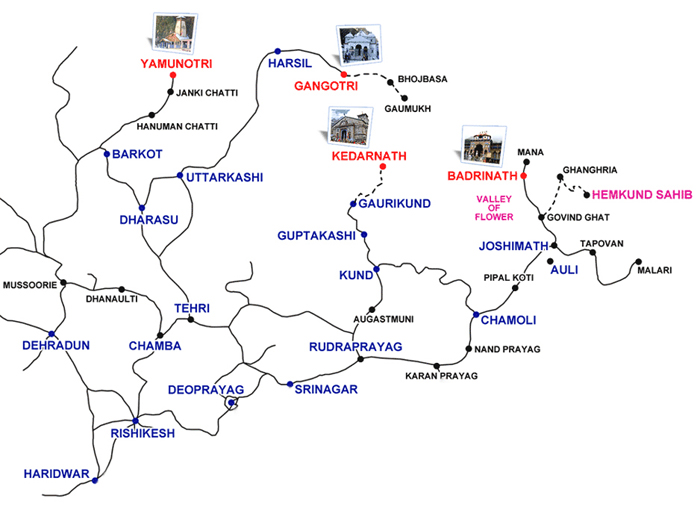Badrinath Dham is one of the most visited pilgrimage centers in India. It is located in Garhwal Hill tracks in Chamoli district along the banks of Alaknanda river at the height of 3133 mts. Badrinath is famous for the Badrinarayan Temple which is dedicated to lord Vishnu. The Nar Parbat is located opposite to the temple, while the Narayana Parbat is located behind the Neelakanth peak. Badrinath is one of the four char dham pilgrimage sites and opens every year for 6 months between end of April and beginning of November. Inside the temple is a 1mt tall black stone idol of Vishnu in the form of Badrinarayan. It is considered by Hindus to be one of the eight swayam vyakta kshetras – self manifested statue of lord Vishnu.
The image of Badrinarayan holds a conch and a wheel in two of its arms in a lifted posture and two arms are rested on its lap in a Padmasana posture.The sanctum also houses images of the god of wealth – Kuber, sage Narad Muni, Uddhav, Nar and Narayan. There are fifteen more images that are also worshipped around the temple. These include that of godess Lakshmi (the consort of Vishnu), Garuda (the vehicle of Narayan), and Navadurga, the manifestation of Durga in nine different forms. The temple also has shrines of Lakshmi Narasimhar and for saints Adi Shankara (788-820 AD), Vedanta Desika and Ramanujacharya. All the idols of the temple are made of black stone.
The Tapt Kund, a group of hot sulphur springs just below the temple, are considered to be medicinal; many pilgrims consider it a requirement to bathe in the springs before visiting the temple. The springs have a year-round temperature of 55 °C (131 °F), while outside temperature is typically below 17 °C (63 °F) all year round. The two water ponds in the temple are called Narad Kund and Surya Kund.
The most prominent festival celebrated in the Badrinath Temple is Mata Murti Ka Mela, which commemorates the descent of river Ganges on mother earth. The Badri Kedar festival is celebrated during the month of June in both the temple and the Kedarnath temple. The festival lasts for eight days; artists from all over the country perform during the function
According to Hindu legend, the god Vishnu sat in meditation at this place, unaware of the cold weather. Lakshmi, his consort, protected him in the form of the Badri tree. Pleased by the devotion of Lakshmi, Vishnu named the place Badrika Ashram. The temple finds mention in several ancient books like Bhagvata Purana ,Skanda Purana and Mahabharata. According to the Bhagvata Purana, “there in Badrikashram the Personality of Godhead (Vishnu), in his incarnation as the sages Nar and Narayana, had been undergoing great penance since time immemorial for the welfare of all living entities”.The Skanda Purana states that “there are several sacred shrines in heaven, on earth, and in hell; but there is no shrine like Badrinath”. The area around Badrinath is also celebrated in Padma Purana as abounding in spiritual treasures. The Mahabharata revered the holy place as the one which can give salvation to devotees arriving close to if, while in other holy places they must perform religious ceremonies. The temple is revered in Nalariya Divya Prabandham, in 11 hymns in the 7th–9th century Vaishnava canon by Periazhwar and in 13 hymns in Thirumangai Azhwar. It is one of the 108 Divyadesam dedicated to Vishnu, who is worshiped as Badrinath.
Although Badrinath is located in North India, the head priest, or Rawal, is traditionally a Nambudiri Brahmin chosen from the South Indian state of Kerala. The Rawal is assisted by the Garhwali Dimri Pundits belonging to the Village Dimmer, Nayab Rawals, Dharmadikari, Vedapathi, a group of priests, Pandas Samadhini, Bhandari, Rasoiyas (cook), devotional singer, clerk of devashram, Jal Bhariya (water keeper) and temple guards. Badrinath is one of the few temples in North India that follow the ancient Tantra-Vidhi of Shrauta tradition more common in the south.
The major pujas performed every morning are mahabhishek (ablution), abhishek, gitapath and bhagavat puja, while in the evening the pujas include geet govinda and aarti. Recital in vedic scripts like Ashtotram and Saharanama is practiced during all the rituals. All the rituals are performed in front of the devotees. After aarti, the decorations are removed from the image of Badrinath and sandalwood paste is applied to it. The paste from the image is given to the devotees the next day as prasad during the nirmalaya darshan.
In 2012, the temple administration introduced a token system for visitors to the temple. Tokens indicating the time of visit were provided from three stalls in the taxi stands. Each devotee to visit the presiding deity is allocated 10–20 seconds. Proof of identity is mandatory to enter the temple. The temple is reached from Rishikesh, located 298 km away via Dev Prayag, Rudra Prayag, Karna Prayag, Nanda Prayag, Joshimutt, Vishnuprayag and Devadarshini. From Kedarnath, visitors can follow the 243 km -long Rudra Prayag route or the 230 km -long Ukthimath and Gopeswar route.
Places to See in Badrinath
Narad Kund: A recess in the river, near Tapt Kund, forming a pool from where the Badrinath idol was recovered.
Brahama Kapal: It is a flat platform a few yards north of the temple and on the bank of river Alaknanda. It is an important place for shhradh ceremony or offering of pinds to ensure a heavenly place for dead ancestors or manes. It is said that offering pind here, the manes are permanently enshrined in heaven and no more pinds are to be done elsewhere ever afterwards. Legends have it that when Shiva chopped of the fifth head of Brahma, it got stuck to his trident. Lastly with the blessing of Lord Vishnu at Badrivan, the head of Brahma fell down from the trident at this place & hence the name Brahma-Kapal (head).
Sheshnetra : It is a large block of stone between tow small seasonal lakes carrying an eye of “Sheshnag” The eye formation is quite natural, 1.5kms. away is a boulder having an impression of the legendary serpent, better known as the Sheshnag’s eye, it is believed that the seshnag waits at this place patiently to accompany the lord on his reincarnation.
Mana Village: Inhabited by an Indo-Mongolian tribe, it is the last Indian village before Tibet. The women of the village offer Choli to the deity on closing day of the temple each year.
Bhim Pul: On the other side of Mana village, a massive rock forming a natural bridge, es over the roaring Saraswati river. It presents a spectacular view of water thundering down through the narrow passage under the rock and is believed to have been placed there by Bhim, the second eldest among the five Pandava brothers.
Vyas Gufa (cave): Near Mana Village, this is a rock-cave where Ved Vyas is believed to have composed the Mahabharata and the pauranic commentaries.


